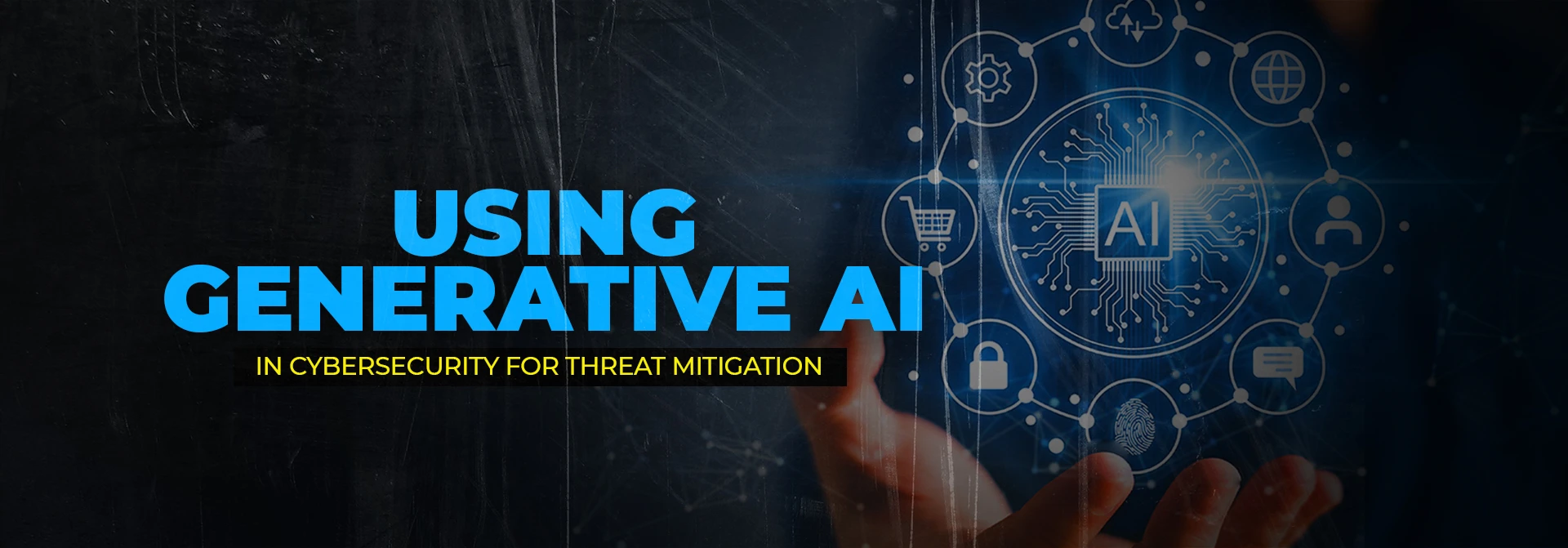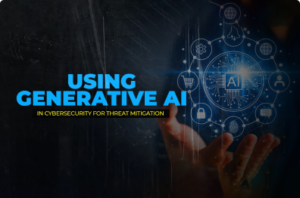A story has two sides, so does artificial intelligence in cybersecurity. With artificial intelligence new cyber threats are born. With AI, cybersecurity experts have improved their ability to detect and respond to threats. Similarly, cyber attackers have evolved their cyber threats too. So, why is Generative AI so difficult to defend against? What makes it so unique?
As traditional cyber defense techniques which analyzes incidents after they occur, Generative AI takes a step forward. It can play a transformative role in cybersecurity, especially in threat identification and response, because of its proactive abilities. Since, the ever-evolving strategies of hackers simply outdo traditional cybersecurity methods, which are based on pre-defined processes and standards and respond after an incident. AI takes a proactive stance through its ability to recognize patterns to spot risks. Thus, providing cybersecurity experts with the edge they need. Let us explore more in this blog how you can use generative AI to identify threats and disrupt cyber-attacks.
AI Driven Cyber Attacks
Before diving into the cybersecurity part, first let’s understand the kind of threats that could occur with Generative AI’s help in cyber space which could be solved through cyber security consulting services.
- Automating Network Attacks: By automating cyberattacks with AI, the cyber-attackers are making it more challenging to counter them with conventional techniques. With the capability to automate certain parts of their attacks, such as locating targets in networks and vulnerabilities and avoiding detection, these hackers can now scale their attacks at a quicker pace.
- Enhanced phishing and social engineering attacks: By abusing the deepfakes, powered by AI, the level of danger in the case of identity theft and scams has only heightened. The compelling realistic techniques for deepfake videos and audio allow scammers to get behind the identity of the victims through social engineering techniques. As a result, it makes it very difficult for cybersecurity professionals to distinguish what’s real and what’s not. This poses a menace not only to individuals but also organizations since the safety of the latter is in the former’s hands.
- AI driven botnets: AI raises the ability to coordinate network of compromised systems (botnets) to launch reconstructed Distributed Denial of Service (DDoS) attacks. The AI botnet used in attacks today is better and harder to search for. Therefore, making it challenging for cybersecurity professionals to identify the attacker. Well, you can always hire our cybersecurity engineer who can assist you in such scenarios.
- AI-Driven Malware and Exploits: Malwares created through AI are more challenging to manage for traditional security software. For instance, shapeshifting threats – this AI-based malware constantly changes its code, so antivirus softwares that relies on recognizing specific patterns can’t keep up. Furthermore, finding the weak spots, AI can scan a system for vulnerabilities and adjust its attack strategy, accordingly, making it more likely to succeed and cause damage.
These are the varied kinds of attacks that could happen with Generative AI, and it makes it riskier to not respond to such threats. To identify and respond to such threats in a timely and proactive manner becomes a crucial aspect for the organizations. This takes us to the next step of journey which is the need to integrate AI in cyber security systems. To defend against AI-powered attacks, cyber security systems themselves must integrate AI. This means leveraging AI-driven threat intelligence, anomaly detection, and predictive analytics to stay forward of evolving threats.
AI Driven Threat Intelligence
Predictive capability is crucial in a digital world where threats are constantly evolving. A compromised system can be prevented if early detection takes place. An organization’s security depends on identifying and responding to threats quickly. So, let’s explore AI-driven threat intelligence in more detail. This could be done by hiring a cyber security engineer.
- AI driven Threat Intelligence: Early warning signals: Artificial intelligence can be used to predict future threats and weaknesses at an early stage.
- Analysis of Predictive Data: AI can analyze data trends to predict potential security threats before they happen.
- Detection of Patterns: The systems excel at identifying suspicious designs and anomalies that may point to a security fault or breach.
- Handling Data Complexity: AI can process and analyze more complex data sets than conventional methods, offering a more comprehensive view of the security picture.
- Intelligent Adaptation: AI-driven threat intelligence is continuously changing and adapting to evolving kinds of cyber threats and staying on top of malicious actors.
Due to the capabilities of Generative AI, we can identify threats and early warning signals at the earliest stage. In addition to protecting organizations from potential dangers, this makes cybersecurity more proactive. Forecasting signs of danger allows organizations to prioritize resources, patch vulnerabilities, and prevent cyberattacks. By doing so, cyberattack damage, losses and repercussions are minimized.
Generative AI and Security from Cyber Attacks
Let’s look at how Generative AI helps in securing organizations or institutions from cyber-attacks:
Automated Incident Response: Reacting quickly and precisely is crucial when managing security situations. Using generative AI, you can automate responses to reduce reaction times. These intelligent systems can find the type of attack immediately and launch pre-planned countermeasures to stop threats in their tracks before they become more dangerous. This automation has several advantages:
- It speeds up and improves the efficiency of the response. It assures everyone that everyone follows the reaction plan precisely even in stressful situations which minimizes mistakes.
- AI systems react to security breaches quickly, reducing threat detection time.
- Automated procedures guarantee consistency and effectiveness.
- There is a lower risk of human error when automation is used
Customized Cybersecurity Solutions
One of the main benefits of generative AI in cybersecurity is its adaptability. Machine learning systems can analyze information in a variety of circumstances, which is why every business has its own security system. This ability simplifies security implementation. It allows for the creation of customized security solutions that closely match the risk matrix and security profile of the organization. Creating tailor-made protection systems based on market dynamics is very effective in providing effective protection systems that are flexibly designed according to market dynamics.
- Customized Security Plans: AI algorithms become flexible, modifying cybersecurity protocols to the special needs of each company and the particular risk patterns it faces.
- Adaptive Learning: This AI system permanently adapts and uses new knowledge acquired to constantly match the organization’s changing security needs.
- Scalability: This being so, AI notably led solutions can give very precise answers for each organization. The solutions can scale up or down to ensure the best possible security.
These ways Generative AI helps in fighting cybersecurity attacks. It offers automated incident response time and customized solutions in identifying threats and responding to them, keeping the cybersecurity system intact.
Challenges and Ethical Considerations
AI into cybersecurity poses challenges and ethical problems. Privacy issues arise when AI systems need access to enormous volumes of data to work effectively. Collection and analysis of sensitive information raises questions about data security and user consent. Additionally, AI algorithms can make biased decisions or infringe on individual privacy rights. This highlights the need for robust regulations and moral frameworks to address these concerns. A balanced strategy is required to address these problems, ensuring that the application of AI in cybersecurity improves security without ruining ethical principles or individual privacy.
Conclusion and Future Insights
The landscape of cybersecurity is an ever-changing digital space. As attackers use Generative AI to create more sophisticated threats, defenders must adopt this similar technology to stay forward. Generative AI provides a strong toolkit for proactive threat identification, incident response, and customized security solutions. Furthermore, AI integration into cybersecurity is not without its challenges. The ethical considerations related to data privacy and the potential misuse of artificial intelligence are equally important to pay attention to. Our ability to harness Generative AI responsibly holds the key to a secure digital world. Integrating both security and ethics is the key to creating an innovative, resilient digital world.

















